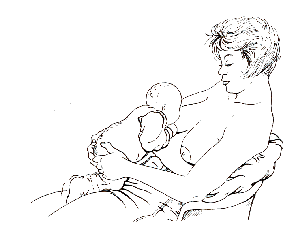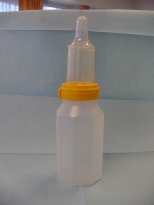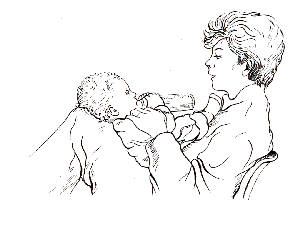Feeding a child with CLP
Different ways for feeding an infant with a CLP
Breastfeeding
the most important reason for choosing a pose for feeding is the position of the head and neck of the child. The child must not turn his neck and the head has to be a little bend forward. This way there is a small chance of swallowing (N.V.S.C.A, 2012).

Breastfeeding on the right. Reprinted from [Breastfeeding on the right] (2012). Copyright 2012 by N.V.S.C.A. Retrieved from https://www.schisis.nl/nvsca/

Breastfeeding sideways. Reprinted from [Breastfeeding sideways] (2012). Copyright 2012 by N.V.S.C.A. Retrieved from https://www.schisis.nl/nvsca/
Some babies have a non-rhythmic suck because of the CLP. In that case the mother can use the dancer-hand position for better support of the baby’s chin. The mother can put her hand under the breast, so she is supporting the breast with three fingers. She can form a U-shape with her hand, using her thumb and forefinger so she is supporting the baby’s chin. In this way the baby can press the nipple more easier between the gums (Children’s Hospitals and Clinics of Minnesota, 2009).

Dancer-hand position. Reprinted from [Dancer-hand position] (2013). Copyright 2013 by Children’s Hospital of Wisconsin. Retrieved from https://www.chw.org/display/PPF/DocID/23451/router.asp
Bottle feeding
When breastfeeding does not work you can use a bottle. You can use a breast pump to put milk in bottles. Feeding by bottle can also have difficulties if the child cannot suck a good vacuum. To make the flow of the feeding more easily, you can make the hole of pacifier bigger. You can do that by making a vertical cut of two millimeters on the front or side of the pacifier. You can also make a cross in the place of the existing hole. It is important to make the hole not too big, because there is a risk of choking then.
The baby still has to suck, so the milk cannot flow out of the bottle. When it does not work with a normal pacifier you can try another or a special pacifier. It is important that you do not use to many different pacifiers and that you ask for help when it does not work.
There are several pacifiers you can use:
- Pacifier with adjustable hole. The advantage of this pacifier is that you can adjust the hole during the feeding. This way you can use for example a small hole when you start the feeding and use a bigger hole when the child gets tired.
- Premature pacifier. When the child can put pressure with his tongue on the pacifier, but can suck vacuum, is a little or soft pacifier easier to drink with. Try to put the pacifier in different ways in the mouth. Sometimes it is easier when the pacifier is slightly more to the left or the right or against the big jaw part in the mouth.
- The Haberman pacifier. This pacifier makes is easier to drink for the child because of the little valve in the pacifier, this makes it easier to suck vacuum. The child needs less strength to drink and you can also adjust the size of the hole, which will also make it easier to drink. (N.V.S.C.A, 2012)

Haberman pacifier. Reprinted from [Haberman-bottle] (2012). Copyright 2012 by N.V.S.C.A. Retrieved from https://www.schisis.nl/nvsca/
The parents will find out what is the most convenient pose for feeding by trying it. Directly body contact during the feeding, were they can look at each other, is for the parent and child comfortable. It makes it easier for the child to burp when he sits straight up. When the parent makes sure that the back and the neck are in the same line, it will be easier for the child to swallow. It is good to have a free hand so you can stimulate the baby during the feeding. By stroking around the mouth you will stimulate the suck reflex. By pushing the lips and cheeks a little forward you can make sure that the mouth fits better around the pacifier (UMC Utrecht, 2013).

Bottle feeding on the knee. Reprinted from [Bottle feeding on the knee] (2012). Copyright 2012 by N.V.S.C.A. Retrieved from https://www.schisis.nl/nvsca/
Children with a cleft have a bigger risk that a bit of nutrition comes out of the nose. It can be that it directly comes through the gap in the hard palate, but it can also be because of a bad closure of the soft palate against the back wall of the throat. It may not look very nice but it mostly does not burden the child. It is important to clean the mouth properly after each feeding moment (N.V.S.C.A, 2012).
